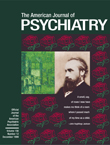Quantitative Study of Signal Hyperintensities on T2-Weighted Magnetic Resonance Imaging in Late-Onset Schizophrenia
Abstract
OBJECTIVE: The authors investigated the extent and distribution of signal hyperintensities on T2-weighted magnetic resonance imaging (MRI) of the brains of subjects with late-onset schizophrenia. METHOD: The study group consisted of 25 subjects with DSM-III-R schizophrenia and onset at age 50 or more years (late-onset schizophrenia) matched group-wise with 24 subjects with early-onset schizophrenia and 30 psychiatrically healthy volunteers. The subjects underwent clinical and neuropsychological assessments and MRI scans. Transaxial T2-weighted and proton-density images were analyzed manually for signal hyperintensities in cerebral and cerebellar white matter, the basal ganglia, thalamus, and brainstem, and quantitative measures were obtained. RESULTS: Subjects with late-onset schizophrenia had greater periventricular hyperintensities measured as widths of periventricular rims and frontal and occipital caps than the two comparison groups. Hyperintense signals elsewhere in the white matter and in the basal ganglia and brainstem did not differ between groups, but the late-onset schizophrenia group had more signal hyperintensities in the thalamus than the normal comparison group. Signal hyperintensities in the frontal-subcortical circuit regions, when considered together, did not differ between groups. Periventricular hyperintensities had significant negative correlations with intelligence, memory, and frontal-executive functioning in the total group. CONCLUSIONS: The finding of increased periventricular hyperintensities and thalamic signal hyperintensities in late-onset schizophrenia suggests the possibility that cerebrovascular disease, in an interaction with some incompletely understood vulnerability factors, may play a role in the pathogenesis of schizophrenia with onset in advanced age.



